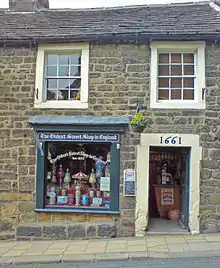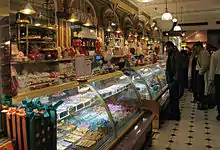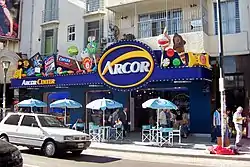Confectionery store
A confectionery store (more commonly referred to as a sweet shop in the United Kingdom, a candy store in North America, or a lolly shop[1] in Australia) sells confectionery and the intended market is usually children. Most confectionery stores are filled with an assortment of sweets far larger than a grocer or convenience store could accommodate. They often offer a selection of old-fashioned treats and sweets from different countries. Very often unchanged in layout since their inception, confectioneries are known for their warming and nostalgic feel.[2][3][4][5] The village of Pateley Bridge claims to have the oldest confectionery store in England.
.jpg.webp)
History
.jpg.webp)
Akisato Ritō's Miyako meisho zue (An Illustrated Guide to the Capital) from 1787 describes a confectionery store situated near the Great Buddha erected by Toyotomi Hideyoshi, then one of Kyoto's most important tourist attractions.[6]
In 1917, there were 55 confectionery shops in Harrisburg, Pennsylvania, which had a population of 70,000 people.[7]

Modern confectionery stores
|
Products
See also
References
| Wikimedia Commons has media related to Candy stores. |
- Bruce Moore, Chief Editor, The Australian Oxford Dictionary, 2nd edition (2004). "Lolly (n)". oxfordreference.com. Retrieved 2011-04-29.CS1 maint: multiple names: authors list (link)
- "Confectionery Timeline". Archived from the original on 2006-08-27. Retrieved 2006-09-10.
- "Fannie May - History of Chocolate". Archived from the original on 2006-10-17. Retrieved 2006-09-10.
- "Orne's Candy Store - History". Archived from the original on 2014-08-19. Retrieved 2014-08-19.
- "CXP Brief A Detailed Description of the Candy Store and Candy Shop- History". Retrieved 2014-08-19.
- Berry, Mary Elizabeth (2006). Japan in Print Information and Nation in the Early Modern Period. Berkeley, California: University of California Press. pp. 182–184. ISBN 9780520254176.
- "BAKERS AND CONFECTIONERS OF HARRISBURG'S OLD EIGHTH WARD, 1890–1917". Penn State University Press. 2005. JSTOR 27778700. Missing or empty
|url=(help) – via JSTOR (subscription required)

.jpg.webp)




